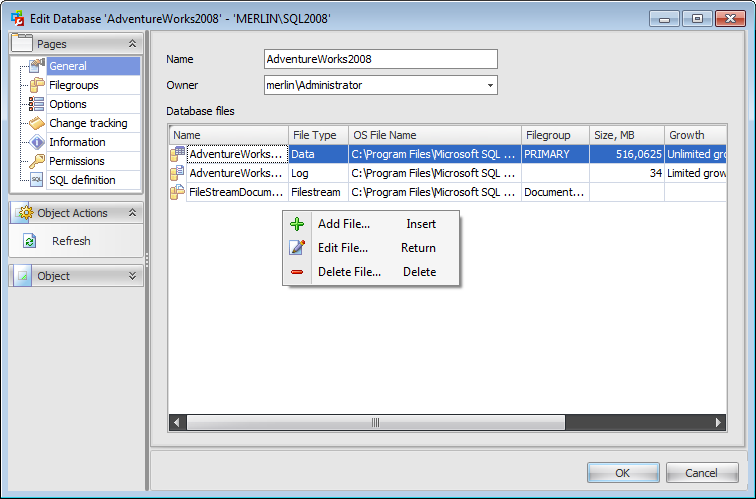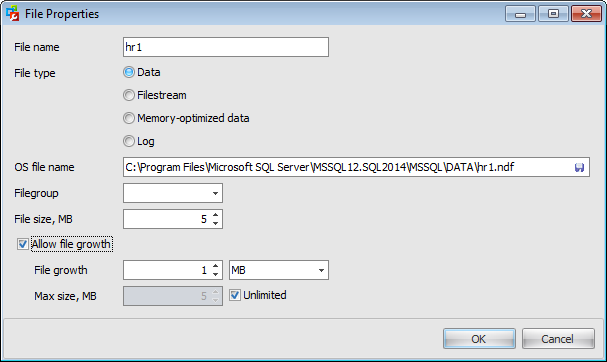Online Documentation for SQL Administrator for SQL Server
General
The General section of the Edit Database window allows you to view and edit main database properties.

Name
Edit the database name.
Owner
Select a database owner from the drop-down list. The database owner is a user that has implied permissions to perform all activities in the database.
Database files
SQL Server databases have three types of files:
- Primary data files
The primary data file is the starting point of the database and points to the other files in the database. Every database has one primary data file. The recommended file name extension for primary data files is *.mdf.
- Secondary data files
Secondary data files make up all the data files, other than the primary data file. Some databases may not have any secondary data files, while others have several secondary data files. The recommended file name extension for secondary data files is *.ndf.
- Log files
Log files hold all the log information that is used to recover the database. There must be at least one log file for each database, although there can be more than one. The recommended file name extension for log files is *.ldf.
In SQL Server, the locations of all the files in a database are recorded in the primary file of the database.
Database files
This list displays information about all data files.
The Name is a logical name used to refer to the physical file in all Transact-SQL statements. The logical file name must conform to the rules for SQL Server identifiers and must be unique within the database.
The Filegroup is the named collection of files that is used to help with data placement and administrative tasks.
The File Type defines the type of an operating-system file.
The OS File Name is the name of the physical file including the directory path. The path must follow the rules for operating system file names.
Double-click the ![]() button to open the File Properties dialog.
button to open the File Properties dialog.
Size, MB
Use the spinner control to specify the original size of the selected database file (in megabytes).
Filegroup
Use the drop-down list to specify a file group the file belongs to. The Primary file group contains the primary data file and any other files not specifically assigned to another file group. All pages for the system tables are allocated in the primary file group. User-defined file groups are any other file groups specified by the user.
Growth
This field shows whether the file size is limited or unlimited and the max size of the limited growth file.
Use the context menu to manage a list of database. It allows you to:
![]() add a new database file
add a new database file
![]() edit the selected database file
edit the selected database file
![]() delete the selected database file
delete the selected database file
When adding a new file or editing the existing one the File Properties window appears. It allows you to enter or edit the database file parameters.

File name
The Name is a logical name used to refer to the physical file in all Transact-SQL statements. The logical file name must conform to the rules for SQL Server identifiers and must be unique within the database.
File type
Select one of the three types of files:
![]() Data
Data
![]() Filestream
Filestream
![]() Memory-optimized data
Memory-optimized data
![]() Log
Log
The OS File Name is the name of the physical file including the directory path. The path must follow the rules for operating system file names.
Click the ![]() button to open the Save File As dialog where you can choose among files and directories stored on the SQL Server.
button to open the Save File As dialog where you can choose among files and directories stored on the SQL Server.
Filegroup
Use the drop-down list to specify a file group the file belongs to. The Primary file group contains the primary data file and any other files not specifically assigned to another file group. All pages for the system tables are allocated in the primary file group. User-defined file groups are any other file groups specified by the user.
File size, MB
Use the spinner control to specify the original size of the selected database file (in megabytes).
![]() Allow file growth
Allow file growth
Check this option to enable automatic file growth.
File growth
Specify a file growth increment (in megabytes or in percent).
Max size, MB
Each file can also have maximum file size specified.
If ![]() Unlimited is specified, the file can continue to grow until it has used all available space on the disk.
Unlimited is specified, the file can continue to grow until it has used all available space on the disk.



































































